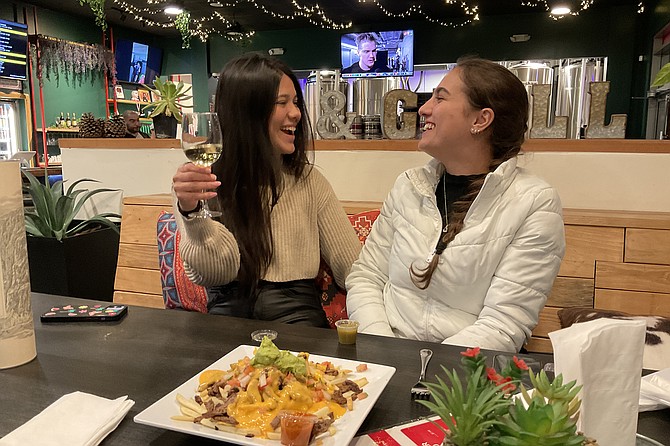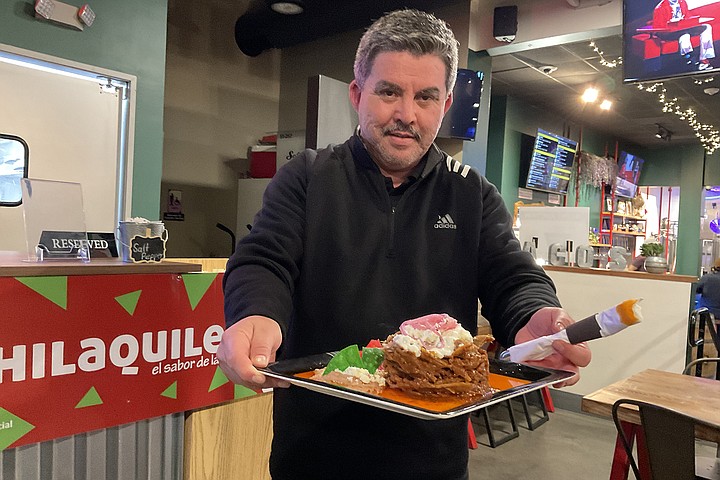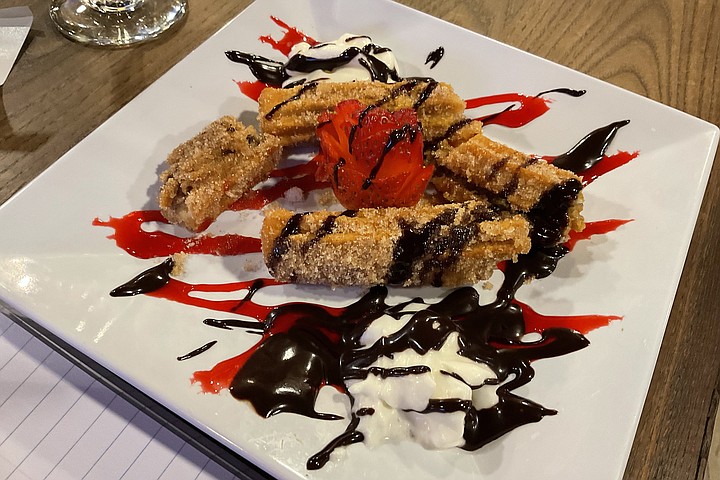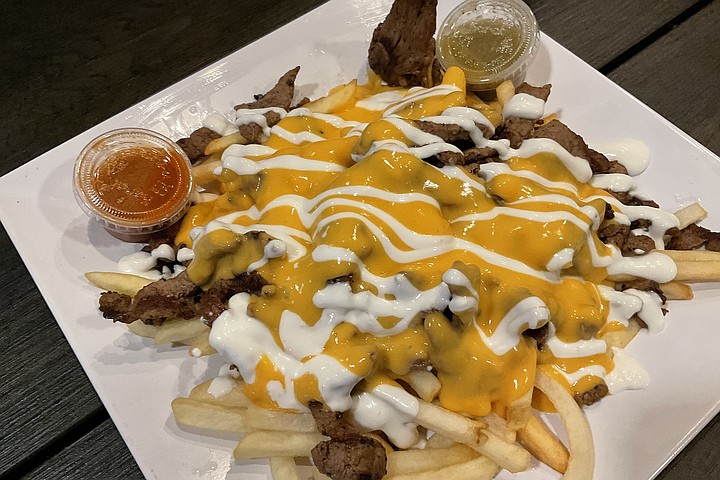 Facebook
Facebook
 X
X
 Instagram
Instagram
 TikTok
TikTok
 Youtube
Youtube

The Aztec drums echo through the barrio. Even at this distance, you can hear the dancers’ ankle rattles shaking with each foot stomp. Chicano Park on this Monday night tells you better than anywhere else about the deep cultures that have met and mixed here in Aztlan. And it tells me that the new sign shining out from across National Avenue is part of some kind of revival. “Los Chilaquiles,” it says, here at the corner of National and Cesar Chavez.
Huh. Because I’ve never given chilaquiles a second thought. Knew next to nothing about them, except they’re tortilla chips cut into triangles, fried, doused in red or green chile salsa, and served up a bit like nachos — filler material for when you’re light of pocket.
But to feature them as your restaurant’s defining dish? I dunno.

Still, got to go in and check things out, specially as it’s now part of the “Attitude” bar and brewery. (It turns out they have other places as well.) Full disclosure: I’m here partly because of chilaquiles curiosity, and partly because Attitude’s brewers make some danged good chelas (cervezas), right here on the spot. (And the one I am in love with right now is their Divine Stout, “earner of the ‘Beyond a Shadow of a Stout’ badge.” (Too late, I notice that they give you a small tulip glass instead of the 16-ounce tumbler, I guess because it’s 10.5 percent alcohol.) Now I’ve gotta eat, and my buddy at the bar says chilaquiles are classically used to absorb alcohol for folks who want to sober up. Good to know.
This place is part of a new wave of more middle-class eateries and cross-cultural watering holes that are signs of the almost inevitable gentrification of Barrio Logan. The place is too close to downtown to be immune from that. The good news is that the barrio’s guardians have so far kept the winds of change down to a gentle breeze. This place, for instance, is built around the idea of one of the oldest Aztec-based foods: corn tortillas, chopped up and covered in a salsa.

Just like nachos, chilaquiles are all about scraping the bottom of the barrel. The beautiful thing is that to make chilaquiles best, you should use a bunch of half-stale corn tortillas. You chop ‘em up and leave ‘em for at least 24 hours, so they become more like cardboard, ’cause then they meld better with the rojas or verde sauces you’re going to pour on. Think slightly soggy, but super-flavorful chips. (Chips? If you’re really cool, you call them totopas.)
So here, it looks like they let you decide on whatever kind of chilaquiles you want. You pay $12.99, then make your choices: first, pick a protein, such as chicken, pork, birria, carne asada, cochinita, carnitas, huevos, or tocino (bacon). Then for, say, chilaquiles rojas (red), you mix in the hot sauce and tomatoes and turn that collection of chips into a casserole. You can make it a salsa verde, too. Success is when you let the tortilla chips become slightly soft, but not beyond the point where they are still somewhat crunchy. That’s the art of the chilaquila pie.
But when my meal comes out, I find I’m not prepared for the color show! For starters, my plate features electric-green and scarlet tortilla chips on top of a pile of frijoles, plus orange-yellow rice, pink sautéed onions, and a burger-shaped squish-up of tortillas and carnitas on an orange and black tray that’s also the plate. Honestly, it looks too pretty to break up into mere food. I’m impressed with the trouble they take. A little hot sauce, a little stout as a sweet swiller, and I’m thinking: what has kept me from this, all these years?
An additional pleasure: we’re eating exactly the same thing as countless Aztec families and soldiers and kings hundreds of years ago, right here. The idea really turns me on, gives me a frisson. A bit like with nachos: we’re talking foods that were ancient when Columbus and Cabrillo sailed the ocean blue. Of course, until recently, most folks thought this was a recent Spanish-Mexican invention. Not so! Aztecs and other local folk have been repurposing leftovers since wa-ay before refrigeration, with the idea that in so doing, they not only saved old food from the slops bin, but benefited from the healing properties of ingredients like aging corn, chocolate mole, sesame seeds, and yes, huitlacoche, the recently re-popularized mold that is supposed to give you the energy to do what a man or woman has to do, heh heh.
Tasting it, it’s hard to imagine there’s all this “Vuelve a la Vida” (“Back to Life”) magic coming out of a bowl of leftovers. But hey, if it worked for Moctazuma and his people, it’s good enough for me.

Natch, there are plenty of alternatives on the menu. One I really want to try next time is the “spinach strawberry,” a kinda salady thing in the “La Dieta” section, with “strawberry dressing (secret recipe), pralines, and feta cheese.” Costs $10.99. But this chilaquiles thing is a strong new current, one of many Native American and Mexican ideas finding its way onto California foodies’ must-eat lists. It’s been fermenting south of the border for years, but now, thanks to multiplying places like this, it’s happening more and more in our fair city.
Plus, hey, those ghostly drums in the distance are always gonna be here to remind us where this-all comes from. On Monday practice nights, anyway.


The Aztec drums echo through the barrio. Even at this distance, you can hear the dancers’ ankle rattles shaking with each foot stomp. Chicano Park on this Monday night tells you better than anywhere else about the deep cultures that have met and mixed here in Aztlan. And it tells me that the new sign shining out from across National Avenue is part of some kind of revival. “Los Chilaquiles,” it says, here at the corner of National and Cesar Chavez.
Huh. Because I’ve never given chilaquiles a second thought. Knew next to nothing about them, except they’re tortilla chips cut into triangles, fried, doused in red or green chile salsa, and served up a bit like nachos — filler material for when you’re light of pocket.
But to feature them as your restaurant’s defining dish? I dunno.

Still, got to go in and check things out, specially as it’s now part of the “Attitude” bar and brewery. (It turns out they have other places as well.) Full disclosure: I’m here partly because of chilaquiles curiosity, and partly because Attitude’s brewers make some danged good chelas (cervezas), right here on the spot. (And the one I am in love with right now is their Divine Stout, “earner of the ‘Beyond a Shadow of a Stout’ badge.” (Too late, I notice that they give you a small tulip glass instead of the 16-ounce tumbler, I guess because it’s 10.5 percent alcohol.) Now I’ve gotta eat, and my buddy at the bar says chilaquiles are classically used to absorb alcohol for folks who want to sober up. Good to know.
This place is part of a new wave of more middle-class eateries and cross-cultural watering holes that are signs of the almost inevitable gentrification of Barrio Logan. The place is too close to downtown to be immune from that. The good news is that the barrio’s guardians have so far kept the winds of change down to a gentle breeze. This place, for instance, is built around the idea of one of the oldest Aztec-based foods: corn tortillas, chopped up and covered in a salsa.

Just like nachos, chilaquiles are all about scraping the bottom of the barrel. The beautiful thing is that to make chilaquiles best, you should use a bunch of half-stale corn tortillas. You chop ‘em up and leave ‘em for at least 24 hours, so they become more like cardboard, ’cause then they meld better with the rojas or verde sauces you’re going to pour on. Think slightly soggy, but super-flavorful chips. (Chips? If you’re really cool, you call them totopas.)
So here, it looks like they let you decide on whatever kind of chilaquiles you want. You pay $12.99, then make your choices: first, pick a protein, such as chicken, pork, birria, carne asada, cochinita, carnitas, huevos, or tocino (bacon). Then for, say, chilaquiles rojas (red), you mix in the hot sauce and tomatoes and turn that collection of chips into a casserole. You can make it a salsa verde, too. Success is when you let the tortilla chips become slightly soft, but not beyond the point where they are still somewhat crunchy. That’s the art of the chilaquila pie.
But when my meal comes out, I find I’m not prepared for the color show! For starters, my plate features electric-green and scarlet tortilla chips on top of a pile of frijoles, plus orange-yellow rice, pink sautéed onions, and a burger-shaped squish-up of tortillas and carnitas on an orange and black tray that’s also the plate. Honestly, it looks too pretty to break up into mere food. I’m impressed with the trouble they take. A little hot sauce, a little stout as a sweet swiller, and I’m thinking: what has kept me from this, all these years?
An additional pleasure: we’re eating exactly the same thing as countless Aztec families and soldiers and kings hundreds of years ago, right here. The idea really turns me on, gives me a frisson. A bit like with nachos: we’re talking foods that were ancient when Columbus and Cabrillo sailed the ocean blue. Of course, until recently, most folks thought this was a recent Spanish-Mexican invention. Not so! Aztecs and other local folk have been repurposing leftovers since wa-ay before refrigeration, with the idea that in so doing, they not only saved old food from the slops bin, but benefited from the healing properties of ingredients like aging corn, chocolate mole, sesame seeds, and yes, huitlacoche, the recently re-popularized mold that is supposed to give you the energy to do what a man or woman has to do, heh heh.
Tasting it, it’s hard to imagine there’s all this “Vuelve a la Vida” (“Back to Life”) magic coming out of a bowl of leftovers. But hey, if it worked for Moctazuma and his people, it’s good enough for me.

Natch, there are plenty of alternatives on the menu. One I really want to try next time is the “spinach strawberry,” a kinda salady thing in the “La Dieta” section, with “strawberry dressing (secret recipe), pralines, and feta cheese.” Costs $10.99. But this chilaquiles thing is a strong new current, one of many Native American and Mexican ideas finding its way onto California foodies’ must-eat lists. It’s been fermenting south of the border for years, but now, thanks to multiplying places like this, it’s happening more and more in our fair city.
Plus, hey, those ghostly drums in the distance are always gonna be here to remind us where this-all comes from. On Monday practice nights, anyway.